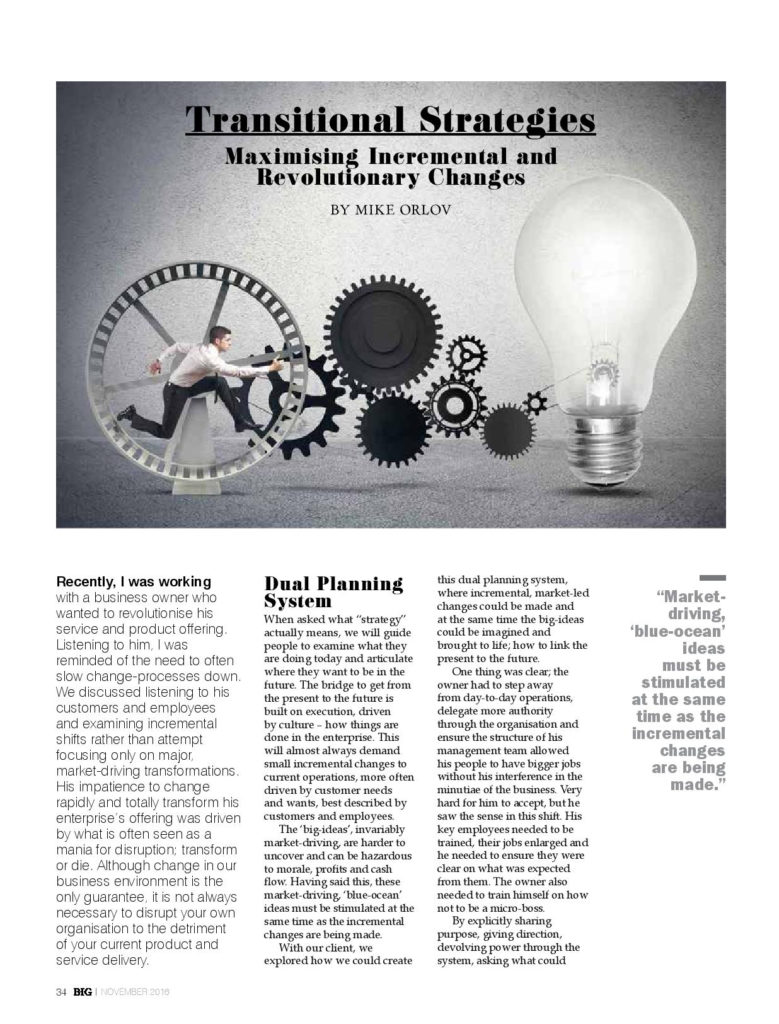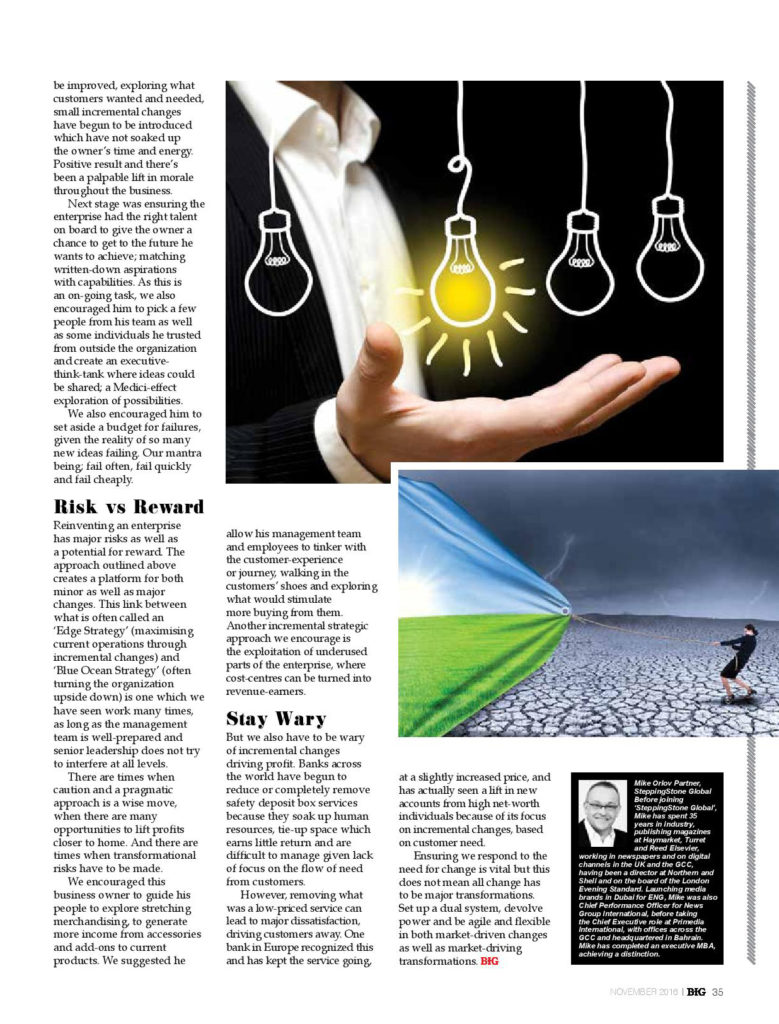Maximising Incremental and Revolutionary Changes
Recently I was working with a business owner who wanted to revolutionise his service and product offering. Listening to him, I was reminded of the need to often slow change-processes down. We discussed listening to his customers and employees and examining incremental shifts rather than attempt focusing only on major, market-driving transformations. His impatience to change rapidly and totally transform his enterprise’s offering was driven by what is often seen as a mania for disruption; transform or die. Although change in our business environment is the only guarantee, it is not always necessary to disrupt your own organisation to the detriment of your current product and service delivery.
Dual Planning System
When asked what “strategy” actually means, we will guide people to examine what they are doing today and articulate where they want to be in the future. The bridge to get from the present to the future is built on execution, driven by culture – how things are done in the enterprise. This will almost always demand small incremental changes to current operations, more often driven by customer needs and wants, best described by customers and employees.
The ‘big-ideas’, invariably market-driving, are harder to uncover and can be hazardous to morale, profits and cash flow. Having said this, these market-driving, ‘blue-ocean’ ideas must be stimulated at the same time as the incremental changes are being made.
With our client, we explored how we could create this dual planning system, where incremental, market-led changes could be made and at the same time the big-ideas could be imagined and brought to life; how to link the present to the future.
One thing was clear; the owner had to step away from day-to-day operations, delegate more authority through the organisation and ensure the structure of his management team allowed his people to have bigger jobs without his interference in the minutiae of the business. Very hard for him to accept, but he saw the sense in this shift. His key employees needed to be trained, their jobs enlarged and he needed to ensure they were clear on what was expected from them. The owner also needed to train himself on how not to be a micro-boss.
By explicitly sharing purpose, giving direction, devolving power through the system, asking what could be improved, exploring what customers wanted and needed, small incremental changes have begun to be introduced which have not soaked up the owner’s time and energy. Positive result and there’s been a palpable lift in morale throughout the business.
Next stage was ensuring the enterprise had the right talent on board to give the owner a chance to get to the future he wants to achieve; matching written-down aspirations with capabilities. As this is an on-going task, we also encouraged him to pick a few people from his team as well as some individuals he trusted from outside the organization and create an executive-think-tank where ideas could be shared; a Medici-effect exploration of possibilities.
We also encouraged him to set aside a budget for failures, given the reality of so many new ideas failing. Our mantra being; fail often, fail quickly and fail cheaply.
Risk vs Reward
Reinventing an enterprise has major risks as well as a potential for reward. The approach outlined above creates a platform for both minor as well as major changes. This link between what is often called an ‘Edge Strategy’ (maximising current operations through incremental changes) and ‘Blue Ocean Strategy’ (often turning the organization upside down) is one which we have seen work many times, as long as the management team is well-prepared and senior leadership does not try to interfere at all levels.
There are times when caution and a pragmatic approach is a wise move, when there are many opportunities to lift profits closer to home. And there are times when transformational risks have to be made.
We encouraged this business owner to guide his people to explore stretching merchandising, to generate more income from accessories and add-ons to current products. We suggested he allow his management team and employees to tinker with the customer-experience or journey, walking in the customers’ shoes and exploring what would stimulate more buying from them. Another incremental strategic approach we encourage is the exploitation of underused parts of the enterprise, where cost-centres can be turned into revenue-earners.
Stay Wary
But we also have to be wary of incremental changes driving profit. Banks across the world have begun to reduce or completely remove safety deposit box services because they soak up human resources, tie-up space which earns little return and are difficult to manage given lack of focus on the flow of need from customers.
However, removing what was a low-priced service can lead to major dissatisfaction, driving customers away. One bank in Europe recognized this and has kept the service going, at a slightly increased price, and has actually seen a lift in new accounts from high net-worth individuals because of its focus on incremental changes, based on customer need.
Ensuring we respond to the need for change is vital but this does not mean all change has to be major transformations. Set up a dual system, devolve power and be agile and flexible in both market-driven changes as well as market-driving transformations.
Transitional Strategies
Maximising Incremental and Revolutionary Changes
Recently I was working with a business owner who wanted to revolutionise his service and product offering. Listening to him, I was reminded of the need to often slow change-processes down. We discussed listening to his customers and employees and examining incremental shifts rather than attempt focusing only on major, market-driving transformations. His impatience to change rapidly and totally transform his enterprise’s offering was driven by what is often seen as a mania for disruption; transform or die. Although change in our business environment is the only guarantee, it is not always necessary to disrupt your own organisation to the detriment of your current product and service delivery.
Dual Planning System
When asked what “strategy” actually means, we will guide people to examine what they are doing today and articulate where they want to be in the future. The bridge to get from the present to the future is built on execution, driven by culture – how things are done in the enterprise. This will almost always demand small incremental changes to current operations, more often driven by customer needs and wants, best described by customers and employees.
The ‘big-ideas’, invariably market-driving, are harder to uncover and can be hazardous to morale, profits and cash flow. Having said this, these market-driving, ‘blue-ocean’ ideas must be stimulated at the same time as the incremental changes are being made.
With our client, we explored how we could create this dual planning system, where incremental, market-led changes could be made and at the same time the big-ideas could be imagined and brought to life; how to link the present to the future.
One thing was clear; the owner had to step away from day-to-day operations, delegate more authority through the organisation and ensure the structure of his management team allowed his people to have bigger jobs without his interference in the minutiae of the business. Very hard for him to accept, but he saw the sense in this shift. His key employees needed to be trained, their jobs enlarged and he needed to ensure they were clear on what was expected from them. The owner also needed to train himself on how not to be a micro-boss.
By explicitly sharing purpose, giving direction, devolving power through the system, asking what could be improved, exploring what customers wanted and needed, small incremental changes have begun to be introduced which have not soaked up the owner’s time and energy. Positive result and there’s been a palpable lift in morale throughout the business.
Next stage was ensuring the enterprise had the right talent on board to give the owner a chance to get to the future he wants to achieve; matching written-down aspirations with capabilities. As this is an on-going task, we also encouraged him to pick a few people from his team as well as some individuals he trusted from outside the organization and create an executive-think-tank where ideas could be shared; a Medici-effect exploration of possibilities.
We also encouraged him to set aside a budget for failures, given the reality of so many new ideas failing. Our mantra being; fail often, fail quickly and fail cheaply.
Risk vs Reward
Reinventing an enterprise has major risks as well as a potential for reward. The approach outlined above creates a platform for both minor as well as major changes. This link between what is often called an ‘Edge Strategy’ (maximising current operations through incremental changes) and ‘Blue Ocean Strategy’ (often turning the organization upside down) is one which we have seen work many times, as long as the management team is well-prepared and senior leadership does not try to interfere at all levels.
There are times when caution and a pragmatic approach is a wise move, when there are many opportunities to lift profits closer to home. And there are times when transformational risks have to be made.
We encouraged this business owner to guide his people to explore stretching merchandising, to generate more income from accessories and add-ons to current products. We suggested he allow his management team and employees to tinker with the customer-experience or journey, walking in the customers’ shoes and exploring what would stimulate more buying from them. Another incremental strategic approach we encourage is the exploitation of underused parts of the enterprise, where cost-centres can be turned into revenue-earners.
Stay Wary
But we also have to be wary of incremental changes driving profit. Banks across the world have begun to reduce or completely remove safety deposit box services because they soak up human resources, tie-up space which earns little return and are difficult to manage given lack of focus on the flow of need from customers.
However, removing what was a low-priced service can lead to major dissatisfaction, driving customers away. One bank in Europe recognized this and has kept the service going, at a slightly increased price, and has actually seen a lift in new accounts from high net-worth individuals because of its focus on incremental changes, based on customer need.
Ensuring we respond to the need for change is vital but this does not mean all change has to be major transformations. Set up a dual system, devolve power and be agile and flexible in both market-driven changes as well as market-driving transformations.


